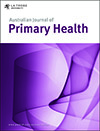Australian Journal of Primary Health
Volume 28
Number 3 2022
Cardiovascular health assessment and management for Aboriginal and Torres Strait Islander peoples remains a high priority within primary health care. Despite this, there is little understanding of gender gaps. This systematic literature review sought to explore whether Aboriginal and Torres Strait Islander women are receiving guideline-recommended care to the same extent as men. Substantial gaps in assessment and management provision exist for women and men alike, and there is a significant gap in gender-specific reporting of assessment and management practices.
Even in the first quarter of 2022, the coronavirus disease 2019 pandemic is causing widespread disruption and challenging public health systems; with climate change and an increasing global population, future pandemics may be more frequent and severe. This article details different initiatives and lessons from the ongoing pandemic for primary care, which can reduce the impact of the present and future pandemics. Closer international cooperation and political will is required to implement these initiatives, especially considering the economic downturn and competing demand for resources.
Offering and providing or arranging preventive care is one of the most important tasks and roles for general practitioners. Electronic clinical record systems used in Australian general practice do not present an overview of each patient’s preventive care status to general practitioners or to patients. Enhancing electronic clinical record systems to invite patients automatically to review and respond to comprehensive information and advice about preventive care that is recommended for them might increase the provision of preventive care at low cost.
Initiatives to close the health gap between First Nations people and other Australians have not been successful to date. The current study co-designed an optimised child health check with a remote Aboriginal Community Controlled Health Organisation, which included consideration of cultural connections and developing screening. All caregivers reported that the health check was culturally appropriate. Data obtained from questions regarding cultural and developmental aspects of health helped to inform providers about the best pathway of support for a child and their family.
Rising health care costs and increasing health inequity in Australia and internationally require investment in high-quality primary health care. In the absence of a definition of high quality in Australian general practice, this paper describes the development of a suite of evidence-based indicators and measures, agreed by key stakeholders to be relevant and feasible. With further validation, these indicators and measures could inform quality improvement and funding for Australian general practice.
The COVID-19 pandemic has facilitated increased accessibility to telehealth in primary care. A survey of 499 consumers revealed a high perception of quality of care and cost savings from the consumer perspective. Key drivers for use of telehealth were reduced travel time and avoiding exposure to COVID-19. Our results suggest that consumers would welcome telehealth as a permanent feature of the primary care system.
Common rhetoric is for low-acuity emergency department presentations to be managed in community-based services, particularly after hours. This study shows that community-based services are already providing care to a substantial volume of patients in the after-hours periods, with different models of care managing different conditions. Policy-makers and health service planners trying to reduce the load of non-urgent presentations to the emergency department need to develop solutions that are cognisant of the load already being carried by community-based services in the after-hours period.
Aboriginal and Torres Strait Islander peoples have a higher prevalence of hepatitis C than Australia’s non-Indigenous populations. This study investigates service-level barriers and facilitators of hepatitis C treatment uptake among clients of Aboriginal Community Controlled Health Services. Our findings assist in overcoming current service-level barriers to hepatitis C treatment among these clients, thus promoting Australia’s hepatitis C elimination goal and improving the health of Aboriginal and Torres Strait Islander peoples.
Despite the accessibility to modern and effective antiviral therapies for the hepatitis C virus, treatment uptake remains unnecessarily low. In the post-interferon era, established barriers and facilitators associated with treatment have changed, and primary healthcare now plays an essential role in the management of hepatitis C. Our research, focusing on the domains of disease awareness, patient engagement and treatment adherence, emphasises the importance of a community-oriented approach, driven by general practice, to ultimately improve uptake of hepatitis C therapy.
National systems-based suicide prevention approaches are increasingly being implemented and community participation is fundamental to their successful implementation. This paper presents finding regarding the community participation process that was undertaken in the Australia’s National Suicide Prevention Trial. These findings could inform future large-scale suicide prevention efforts in Australia and internationally.
People who experience incarceration often have complex health needs and poor access to community-based services. We show that after release from prison, a cohort in Queensland used hospital-based services frequently, incurring high costs from the government perspective. Investment in transitional support and community-based health services to address the health needs of people leaving prison may be cost-effective.
 , Jayden Nguyen, Anna Dowling, Natasha J. Howard, Christine Franks, Susan Hillier, Vicki Wade, Veronica King, Janice Rigney, Nyunmiti Burton, Julie Anne Mitchell, Stephen J. Nicholls, Catherine Paquet and Alex Brown
, Jayden Nguyen, Anna Dowling, Natasha J. Howard, Christine Franks, Susan Hillier, Vicki Wade, Veronica King, Janice Rigney, Nyunmiti Burton, Julie Anne Mitchell, Stephen J. Nicholls, Catherine Paquet and Alex Brown




